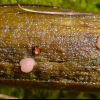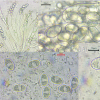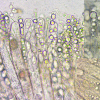
24-12-2025 17:08
Hulda Caroline HolteHello, I have found this propoloid ascomycete on

21-12-2025 09:32
Hello.A tiny ascomycete found embedded in wood in

21-12-2025 21:32
Pol DebaenstHello, Garden, Burgweg 19, Veurne, BelgiumOn 10/1

22-12-2025 23:38
Patrice TANCHAUDBonsoir, récolte sur un mur en pierre, apothéci

22-12-2025 00:47
Patrice TANCHAUDBonsoir, récolte à proximité du milieu dunaire
Iodophanus hyperboreus?
Lothar Krieglsteiner,
02-08-2024 10:07
 .. found in the French Alps, 5.7.24, 1455 m NN, two quite large apothecia (about 2-3 mm) with beautiful rosy-pink tint growing on a very strongly decayed and water-soaked piece of wood lying in a fountain situation between mosses like Cratoneuron commutatum and Philonotis fontana, wet situation (in the surrounding nearly every habitat was fully dried out). The nitrogen-level was low which is indicated already by the mosses, and by spermatophytes (e.g. Parnassia palustris, Pinguicula vulgaris not far away).
.. found in the French Alps, 5.7.24, 1455 m NN, two quite large apothecia (about 2-3 mm) with beautiful rosy-pink tint growing on a very strongly decayed and water-soaked piece of wood lying in a fountain situation between mosses like Cratoneuron commutatum and Philonotis fontana, wet situation (in the surrounding nearly every habitat was fully dried out). The nitrogen-level was low which is indicated already by the mosses, and by spermatophytes (e.g. Parnassia palustris, Pinguicula vulgaris not far away).The sea level is perhaps a bit low, but I think I. hyperboreus should be a better choice than I. testaceus. I measured the spores with about 19-21/11,5-13 µm. My cotton blue stain was not very good working, maybe because of the very wet water-soaked material. The spores were finely warty . The paraphyses are perhaps distinctive, too - they are swollen and strongly guttulate.
Can I. hyperboreus be confirmed or am I fully on a wrong road?
Best regards, Lothar
Nicolas VAN VOOREN,
02-08-2024 15:45

Re : Iodophanus hyperboreus?
Why not simply I. carneus? It usually grows on dungs, but on a decaying substrate it might be possible...
To my knowledge, I. hyperboreus is terrestrial and has smaller ascospores.
To my knowledge, I. hyperboreus is terrestrial and has smaller ascospores.
Lothar Krieglsteiner,
02-08-2024 15:55

Re : Iodophanus hyperboreus?
Hello Nicolas,
thanks for your opinion.
But ....
Medardi & al. 2006 for his new species hyperboreus: Sp 18-23/10-12 µm
In his key he gives for I. carneus measures of 17-19/10-11,5 and for I. testaceus 17,5-22,5/10,5-14,5
In Prokhorov 1997 I find for I. carneus 15-20/10-12, and for I. testaceus 18-22,5/12-13,5
My measures were (I repeat): 19-21/11,5-13
.
Wood (stronly decayed) or not wood is in my eyes less important than the nitrogen situation (carenus and testaceus are known as strong nitrophytes, and so I always found them before), I. hyperboreus grows at wet (and cold - ... yes) that are nitrogen-poor. I think the ecology is more like my find than that of carneus/testaceus.
Best regards, Lothar
thanks for your opinion.
But ....
Medardi & al. 2006 for his new species hyperboreus: Sp 18-23/10-12 µm
In his key he gives for I. carneus measures of 17-19/10-11,5 and for I. testaceus 17,5-22,5/10,5-14,5
In Prokhorov 1997 I find for I. carneus 15-20/10-12, and for I. testaceus 18-22,5/12-13,5
My measures were (I repeat): 19-21/11,5-13
.
Wood (stronly decayed) or not wood is in my eyes less important than the nitrogen situation (carenus and testaceus are known as strong nitrophytes, and so I always found them before), I. hyperboreus grows at wet (and cold - ... yes) that are nitrogen-poor. I think the ecology is more like my find than that of carneus/testaceus.
Best regards, Lothar



